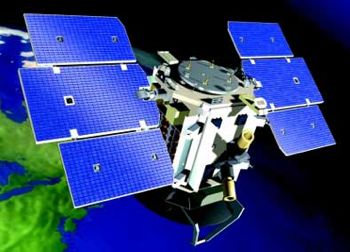
Home - Search - Browse - Alphabetic Index: 0- 1- 2- 3- 4- 5- 6- 7- 8- 9
A- B- C- D- E- F- G- H- I- J- K- L- M- N- O- P- Q- R- S- T- U- V- W- X- Y- Z
Cloudsat
 Cloudsat Credit: Manufacturer Image |
Status: Operational 2006. First Launch: 2006-04-28. Last Launch: 2006-04-28. Number: 1 . Gross mass: 848 kg (1,869 lb).
CloudSat was selected as a NASA Earth System Science Pathfinder satellite mission in 1999 to provide observations necessary to advance our understanding of cloud abundance, distribution, structure, and radiative properties. CloudSat flew the first satellite-based millimeter-wavelength cloud radar, that was more than 1000 times more sensitive than existing weather radars.
CloudSat was co-manifested with the Calipso (Cloud-Aerosol Lidar and Infrared Pathfinder Satellite Observations) satellite for launch aboard a Delta II rocket. CloudSat and Calipso joined three satellites already in orbit ( Aqua, Parasol, and Aura) to form a constellation of satellites known as the A-Train. The satellites flew in a nearly circular orbit with an equatorial altitude of approximately 705 km. The orbit was sun-synchronous, maintaining a roughly fixed angle between the orbital plane and the mean solar meridian. CloudSat maintained a close formation with Aqua and a particularly close formation with Calipso, providing near-simultaneous and collocated observations with the instruments on these two platforms.
Science leader for CloudSat was Graeme Stephens of Colorado State University. NASA's Jet Propulsion Laboratory provided project and mission management and developed CloudSat's instrument, the Cloud Profiling Radar.
CloudSat's primary mission was scheduled to continue for 22 months after launch, in order to allow more than one seasonal cycle to be observed, although radar lifetime data indicates that the radar was expected to operate for three years with a 99 percent probability.
The Cloud Profiling Radar (CPR) was a 94-GHz nadir-looking radar which measured the power backscattered by clouds as a function of distance from the radar. The CPR was developed jointly by NASA/JPL and the Canadian Space Agency (CSA). The overall design of the CPR was simple, well understood, and had strong heritage from many cloud radars already in operation in ground-based and airborne applications. Most of the design parameters and subsystem configurations were nearly identical to the Airborne Cloud Radar, which had been flying on a NASA DC-8 aircraft since 1998.
CPR System Characteristics:
- Nominal Frequency: 94 GHz
- Pulse Width: 3.3 microsec
- PRF: 4300 Hz
- Minimum Detectable Z*: -26 dBZ
- Data Window: 0-25 km
- Antenna Size: 1.95 m
- Dynamic Range: 70 dB
- Integration Time: 0.3 sec
- Vertical Resolution: 500 m
- Cross-track Resolution: 1.4 km
- Along-track Resolution: 2.5 km
- Data Rate: 15 kbps
More at: Cloudsat.
Family: Earth, Earth weathersat, Sun synchronous orbit. Country: USA. Launch Vehicles: Delta, Delta 7420-10C. Launch Sites: Vandenberg, Vandenberg SLC2W. Agency: NASA, Ball. Bibliography: 2.
Back to top of page
Home - Search - Browse - Alphabetic Index: 0- 1- 2- 3- 4- 5- 6- 7- 8- 9
A- B- C- D- E- F- G- H- I- J- K- L- M- N- O- P- Q- R- S- T- U- V- W- X- Y- Z
© 1997-2019 Mark Wade - Contact
© / Conditions for Use